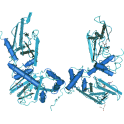
- Remove this product from my favorite's list.
- Add this product to my list of favorites.
Products
Viewed products
Newsletter
 |  |  |  |  |  |

Background: cAMP-dependent protein kinase (PKA) is an ubiquitous serine/theonine protein kinase present in a variety of tissues (e.g. brain, skeletal muscle, heart). The intracellular cAMP level regulates cellular responses by altering the interaction between the catatytic C and regulatory R subunits of PKA. The inactive tetrameric PKA holoenzyme R2C2 is activated when cAMP binds to R2, which dissociates the tetramer to R2*cAMP4 and two active catalytic subunits. Free Catalytic subunits of PKA can phosphorylate a wide variety of intracellular target proteins. In response to hormone-induced high cAMP levels, PKA phosphorylates glycogen synthetase (inhibition of the enzyme activity) and phosphorylase kinase to block glycogen synthesis. Different isoforms of catalytic and regulatory subunits suggest specific functions. The recombinant RIα regulatory subunit supplied by Biaffin is a 86 kDa dimeric protein (monomer 43 kD).
Dimeric protein specifically inhibiting PKA catalytic subunit (Ki about 0.1nM). Activity can be restored by adding cAMP. The binding of the catalytic subunit is dependent on the presence of ATP and Mg.
Theoretical MW: 86 kDA (dimeric protein)
Expression system: E. coli
Storage buffer: 20 mM Mops (pH 7.0), 150 mM NaCl, 20% glycerol
Purity: >95% (SDS-PAGE)
Protein concentration: 0.38 mg/ml (Bradford method using BSA as standard protein)
Inhibitory Activity: The cAMP-dependent protein kinase, regulatory subunit RIα reversibly inhibits the catalytic subunit Cα of the cAMP-dependent protein kinase PKA. The inhibition of the catalytic subunit can be reversed by the addition of the second messenger cAMP (> 1µM).
Entrez Gene ID: 5573
UniProtKB: P10644
Ordering information: shipped on dry ice
Tortora G, Yokozaki H, Pepe S, Clair T, Cho-Chung YS (1991) "Differentiation of HL-60 leukemia by type I regulatory subunit antisense oligodeoxynucleotide of cAMP-dependent protein kinase" Proc. Natl. Acad. Sci. U S A 88(5):2011-5
Tasken K, Skalhegg BS, Hansson V et al. (1993) "Novel isozymes of cAMP-dependent protein kinase exist in human cells due to formation of RI alpha-RI beta heterodimeric complexes" J. Biol. Chem. 268 (28): 21276-83
Cho-Chung YS, Clair T (1993) "The regulatory subunit of cAMP-dependent protein kinase as a target for chemotherapy of cancer and other cellular dysfunctional-related diseases" Pharmacol. Ther. 60(2):265-88
Ciardiello F, Pepe S, Tortora G et al. (1993) "Down-regulation of RI alpha subunit of cAMP-dependent protein kinase induces growth inhibition of human mammary epithelial cells transformed by c-Ha-ras and c-erbB-2 proto-oncogenes" Int. J. Cancer 53(3):438-43
Leon DA, Herberg FW, Banky P, Taylor SS (1997) "A stable alpha-helical domain at the N terminus of the RIalpha subunits of cAMP-dependent protein kinase is a novel dimerization/docking motif" J. Biol. Chem. 272(45):28431-7
McDaid HM, Cairns MT, Johnston PG et al. (1999) "Increased expression of the RIalpha subunit of the cAMP-dependent protein kinase A is associated with advanced stage ovarian cancer" Br. J. Cancer 79(5-6):933-9
Recombinant human cAMP-dependent protein kinase: PKA, holo type I alpha, 25 µg - 385,00 €
Recombinant cAMP-dependent protein kinase: PKA, holo type II alpha, 25 µg - 385,00 €
8-Br-cAMP, 100 µmol - 66,00 €
cAMP, 500 µmol (~176 mg) - 70,00 €
8-Cl-cAMP, 10 µmol (~4 mg) - 127,00 €
8-CPT-cAMP, 100 µmol - 109,00 €
DB-cAMP, 100 µmol - 59,00 €
PKI, 100 µg - 125,00 €
Follow us